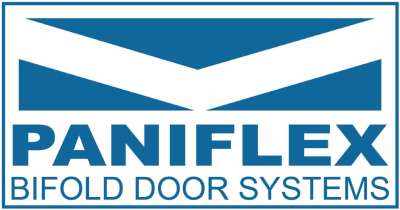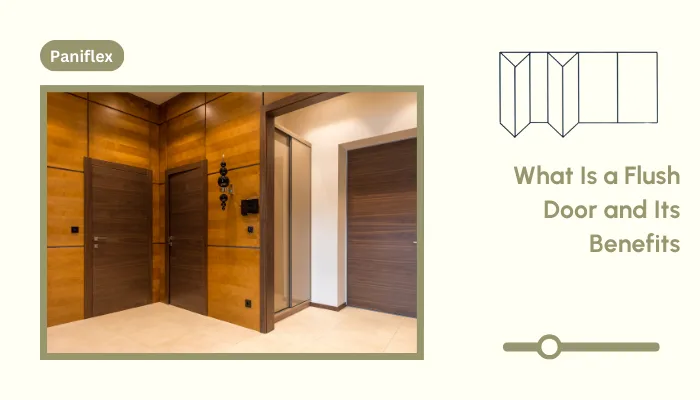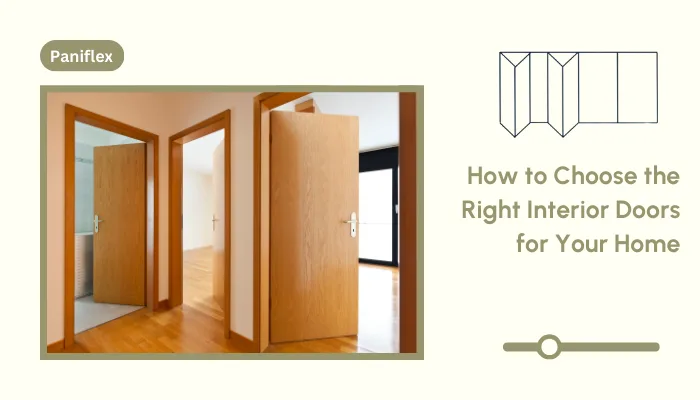Flush doors have become a staple in modern architecture and interior design, offering clean lines and a minimalist appeal. Unlike traditional panel doors, their smooth, flat surfaces create a seamless look that suits contemporary spaces.
We understand the challenge professionals face when balancing style, functionality, and budget in their projects. Flush doors provide a practical solution without compromising on design or durability.
This guide explains what flush doors are, explores their types, and highlights key benefits that make them ideal for both residential and commercial applications.
Ready to experience the benefits of custom closet doors? Explore our range of Paniflex products now.
Here’s the short version:
- A flush door has a flat, smooth surface with a minimalist design, constructed using solid or hollow cores covered by veneers, laminates, or paint.
- Flush doors offer durability, easy maintenance, and versatile finishing options, making them suitable for modern interiors and commercial spaces.
- They are ideal for professionals seeking cost-effective, stylish, and functional doors that perform well in high-traffic and moisture-prone areas.
- Proper installation and regular maintenance can significantly extend the lifespan of flush doors, thereby preventing common issues such as swelling or misalignment.
What Is a Flush Door?
A flush door is a flat-surfaced door with no raised or recessed panels, offering a clean, minimalist appearance. Its design typically consists of a solid or hollow core covered by plywood, MDF, or laminate sheets for a seamless finish.
Flush doors are widely used in both residential and commercial settings for their simplicity and adaptability. They fit modern interiors where designers prioritize straight lines and an uncluttered look.
They are also lightweight, easy to install, and compatible with various surface finishes, including veneers, laminates, and paints, making them highly versatile for different design styles.
While all flush doors share a smooth, flat design, they vary significantly in core construction and applications. The next section explores the different types of flush doors and where each works best.
Suggested Watch: This informative video discusses what flush doors are and the various types available.
Types of Flush Doors and Their Applications

Flush doors are not one-size-fits-all. Their construction and core materials determine their suitability for different spaces. Understanding these variations helps professionals specify the right door for each project.
- Solid Core Flush Doors
Solid core flush doors have a dense, engineered wood or particleboard core. They provide excellent strength, sound insulation, and resistance to impact, making them ideal for high-traffic areas like offices, schools, and apartment entrances.
- Hollow Core Flush Doors
Hollow core doors feature a lightweight framework with cardboard or honeycomb fillings. These doors are cost-effective and easy to handle, making them suitable for interior use in residential spaces such as bedrooms and closets.
- Laminated Flush Doors
These doors are finished with a laminate surface that enhances durability and provides resistance to scratches and moisture. Laminated flush doors are often chosen for kitchens, bathrooms, and other moisture-prone areas.
- Veneered Flush Doors
Veneered flush doors have a thin layer of natural wood veneer on the surface, offering a premium appearance. They work well in spaces where design is a priority, such as hotel lobbies, boardrooms, or luxury residences.
- Fire-Rated and Acoustic Flush Doors
Specialized flush doors with fire-resistant cores or soundproofing materials are essential in commercial buildings, hospitals, and hotels. These provide critical safety and acoustic performance without compromising design.
Each type of flush door offers unique advantages, but why should professionals choose them over traditional options? The next section highlights the key benefits of flush doors for modern projects.
Suggested Read: How to Install Sliding Closet Door Floor Guides on Various Surfaces
Benefits of Using Flush Doors in Modern Projects
Flush doors are valued not just for their sleek appearance but also for their practical advantages in a variety of applications. Their design and material options make them a go-to choice for architects and contractors seeking reliable, cost-effective solutions.
- Minimalist Style
With clean lines and flat surfaces, flush doors complement contemporary interiors. They blend seamlessly with walls and design elements, creating a cohesive look that works in both residential and commercial environments.
- Cost-Effective and Easy to Install
Flush doors are simpler to manufacture and install compared to traditional panel doors. This makes them a budget-friendly option for large projects without compromising on style or performance.
- Durability for Everyday Use
Solid core flush doors provide excellent strength and resistance to wear and tear, making them ideal for high-traffic areas such as offices, schools, and hotels.
- Versatile Finishing Options
From natural wood veneers to laminates and paints, flush doors can be customized to match any design scheme. This versatility gives professionals the freedom to meet client expectations across diverse projects.
- Low Maintenance Requirements
The smooth surfaces of flush doors make them easy to clean and maintain. Their construction minimizes the risk of cracks or splits, extending their lifespan in busy settings.
While flush doors offer broad benefits, certain environments demand even more from their performance. The next section explores why they are particularly suited for high-traffic and moisture-prone areas.
Suggested Read: DIY Ideas for Replacing HVAC and AC Closet Doors
Why are Flush Doors Ideal for Moisture-Prone Areas?
Flush doors are designed to handle the challenges of spaces that see frequent use and exposure to moisture. Their construction and finish options make them a practical choice for demanding environments.
- Resistant to Warping and Swelling: Factory-sealed edges and high-quality laminates protect against moisture, reducing the risk of distortion in kitchens, bathrooms, and coastal areas.
- Durability Under Heavy Use: Solid core flush doors withstand frequent opening and closing without loosening hardware or showing signs of wear.
- Low Maintenance in Busy Settings: Smooth surfaces are easy to clean and less prone to dirt buildup, ideal for hospitals, schools, and commercial spaces.
- Enhanced Hygiene Benefits: Laminated finishes resist moisture and bacteria, making them suitable for environments where cleanliness is a priority.
- Acoustic and Fire-Rated Options: Specialized flush doors offer enhanced protection in hotels, offices, and multi-family housing, where safety and noise control are paramount.
Despite these advantages, some professionals hesitate to specify flush doors due to outdated perceptions. The next section addresses common misconceptions and clarifies how modern flush doors outperform older designs.
Common Misconceptions About Flush Doors
Flush doors often get overlooked due to lingering myths. Addressing these misconceptions helps professionals make confident design and specification decisions.
- Flush Doors Are Low Quality
This is one of the most common myths. Modern flush doors with solid cores and premium finishes provide excellent durability, rivaling panel doors in strength and appearance.
- Unsuitable for Commercial Spaces
Many assume flush doors cannot handle heavy use. In reality, solid core and fire-rated flush doors are widely used in hotels, offices, and hospitals due to their resilience and compliance with safety standards.
- Lack of Visual Appeal
While they have a minimalist design, flush doors can be customized with veneers, laminates, or paint finishes to achieve sophisticated and elegant looks tailored to modern interiors.
- Flush Doors Cannot Handle Moisture
The belief that flush doors swell or warp easily is outdated. High-quality laminated and factory-sealed options are ideal for moisture-prone areas like bathrooms and kitchens.
- Flush Doors Require More Maintenance
Unlike panel doors, flush doors have flat surfaces that are easier to clean and maintain. They resist dust accumulation and are less prone to cracking or splitting.
With these misconceptions cleared, it becomes easier to see how flush doors compare to traditional options. The next section highlights their differences from panel and solid core doors.
Suggested Read: Simple Steps to Install a Door in a Hallway
Comparing Flush Doors to Panel and Solid Core Doors
Choosing the right door type depends on looks, performance needs, and budget. Understanding how flush doors differ from traditional panel and solid core doors helps professionals recommend the best option for each project.
| Feature | Flush Doors | Panel Doors | Solid Core Doors |
|---|---|---|---|
| Design | Smooth, flat surface with minimalist appeal | Raised or recessed panels with classic detailing | Similar appearance to panel doors with solid build |
| Core Construction | Hollow or solid core | Solid wood panels and rails | Dense particleboard or engineered wood core |
| Durability | High (solid core), moderate (hollow core) | Very high, especially in solid wood | Excellent, resists warping and impact |
| Cost | More cost-effective, especially hollow core | Higher due to complex construction | Mid to high range, depending on finish |
| Maintenance | Easy to clean and maintain | Requires more care to avoid dirt in grooves | Low maintenance with good durability |
| Best Applications | Modern interiors, commercial spaces, high traffic | Traditional homes, luxury projects, historic spaces | Apartments, offices, and high-traffic areas |
Regardless of door type, proper care is essential for long-term performance. The next section shares practical maintenance tips to help flush doors maintain their look and functionality for years.
From the Community: This Reddit thread discusses the cheaper option between flush doors and panel doors.
Maintenance Tips to Maximize Flush Door Lifespan

Proper care helps flush doors retain their appearance and functionality for years. These simple practices minimize wear and prevent common issues, such as swelling, surface damage, and misaligned hardware.
- Regular Cleaning: Wipe surfaces with a soft, damp cloth to remove dust and grime. Avoid abrasive cleaners that can damage finishes.
- Check for Moisture Exposure: Inspect door edges and frames in kitchens and bathrooms for signs of swelling or water damage.
- Lubricate Hardware: Apply light lubricant to hinges and locks annually to ensure smooth operation and prevent squeaks.
- Inspect Seals and Finishes: Look for chipped paint, peeling laminates, or worn edges and address them promptly to maintain moisture resistance.
- Avoid Excessive Force: Prevent damage by ensuring doors are not slammed or forced open beyond their intended range.
- Control Indoor Humidity: Use dehumidifiers in areas prone to moisture to reduce the risk of swelling, especially for wood-veneer flush doors.
Alongside regular maintenance, selecting the right flush door at the outset ensures better long-term performance. The next section outlines key factors professionals should consider when specifying flush doors for their projects.
Choosing the Right Flush Door for Your Project
The right flush door choice depends on function, style, and environmental demands. Professionals must weigh these factors to deliver doors that perform well and satisfy client expectations.
- Core Material: Solid core doors offer better strength and sound insulation, while hollow core options are lighter and more affordable for low-traffic areas.
- Surface Finish: Select from laminates, veneers, or paint finishes based on your desired look and resistance to wear.
- Moisture Resistance: Specify laminated or factory-sealed flush doors for kitchens, bathrooms, and coastal projects to prevent swelling and warping.
- Hardware Compatibility: Ensure the door pairs with durable hinges, locks, and handles suitable for the door’s weight and usage frequency.
- Acoustic and Fire-Rated Needs: For hotels, offices, or multi-family residences, consider flush doors designed to meet specific safety and performance standards.
Custom Door & Mirror offers flush door solutions that address these key considerations with durable materials and precision engineering. The next section explores how their products support professionals in delivering long-lasting results.
Door Solutions by Custom Door & Mirror
Custom Door & Mirror designs custom doors with professionals in mind, offering products that combine durability, style, and ease of installation. These solutions address the most common challenges architects, interior designers, and contractors face when specifying doors for high-use environments.
Solid Core Construction
Our flush doors feature solid cores that resist impact, warping, and daily wear. This makes them ideal for high-traffic residential and commercial spaces. The result is fewer callbacks and longer-lasting installations.
Patented TruClose Hinges
TruClose hinges ensure doors close securely every time and maintain alignment even under frequent use. They are engineered for smooth, consistent performance, reducing the need for hardware adjustments or replacements.
Factory-Applied Finishes
All edges and surfaces are factory sealed with premium finishes that block moisture infiltration. This enhances performance in kitchens, bathrooms, and coastal environments where humidity can damage traditional doors.
Customization Options
With a variety of veneers, laminates, and color options, our flush doors fit seamlessly into any style. Professionals can meet client expectations without sacrificing durability or ease of maintenance.
Easy Maintenance and Longevity
Our doors are designed for minimal upkeep, with smooth surfaces that resist dust and stains. Durable materials and precision engineering extend their lifespan, even in demanding environments.
Custom Door & Mirror flush doors offer a balance of performance and style that helps professionals deliver superior results. Built to last and designed to impress, they are a smart choice for any project.
Ready to experience the benefits of custom closet doors? Explore our range of Paniflex products now.
Conclusion
Flush doors offer a versatile solution for modern spaces, balancing clean looks with practical performance. From residential interiors to high-traffic commercial environments, they meet the demands of both designers and contractors with ease. Understanding their types, benefits, and maintenance needs helps professionals make informed choices that enhance project outcomes.
Custom Door & Mirror delivers flush door solutions engineered for durability, style, and minimal maintenance. With solid construction, patented hardware, and factory finishes, these doors are built to perform in any setting.
Contact us today to discover flush doors that offer durable strength and modern design versatility.
Frequently Asked Questions
- What are the advantages of flush doors?
Flush doors offer a sleek, minimalist look, cost-effective production, and easy maintenance. They are durable, lightweight, and versatile, with options like solid core for strength and laminates for moisture resistance in high-traffic or moisture-prone areas.
- What are flush doors typically used for?
Flush doors are commonly used in residential interiors, offices, hotels, and schools. Their flat design suits modern looks, while their construction allows installation in bedrooms, kitchens, bathrooms, and commercial spaces where functionality and style are equally important.
- What is the life expectancy of a flush door?
A high-quality flush door with proper maintenance can last 15–20 years or more. Solid core doors generally offer longer lifespans compared to hollow core options, especially in high-traffic or moisture-prone environments where durability is critical.
- Is a flush door good for a bathroom?
Yes, laminated or factory-sealed flush doors are suitable for bathrooms. They resist moisture, minimize swelling, and are easy to clean, making them a practical choice for wet areas when specified with appropriate finishes and hardware.






